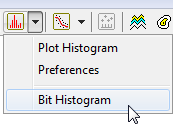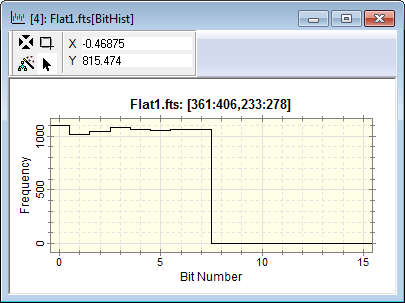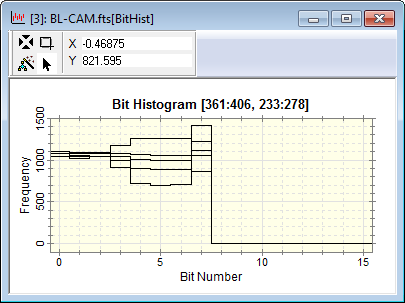
-
Create the Bit Histogram plot using the Measure > Diagnostics > Bit Histogram command. or use the drop-button menu beside the Histogram button on the main toolbar (shown at left).
Bit Histogram Plot
The Bit Histogram command plots a histogram of the frequency of bit values in the digital image, as sampled inside the image cursor. The histogram frequency measures the occurrence of each power of 2 in the values of the pixels, as measured in digital counts (e.g., Analog to Digital Units, ADU, or Digital Number, DN). This type of plot is helpful for assessing whether the camera's A/D Converter is performing correctly and whether it is limited by random noise or favors certain bits.
|
|
|
The example below shows two examples of a bit histogram: a single image and all 5 images in an image set, shown with the Plot Window in Overlay mode.


In a digital image, pixel values are represented as binary numbers which are the sums of powers of 2. For example, a pixel value of 2 has a binary representation of 2 = 2 + 0 = (1*21) + (0*20). A bit histogram plot would represent a pixel with value "2" as adding 1 to the frequency of bit 1 and nothing to the frequency of any of the other bits. Similarly, a pixel value of 21 would be represented as follows: 21 = 16 + 4 + 1 = (1*24) +(1*22) + (0*20), and the bit histogram would show this as 1 add to the frequency in each of the bins at x = 4, 2, and 0. A pixel value of 16384, or 1*214, would add 1 to the frequency of bit 14 in the bit histogram. In the ideal case, in which the noise is total randomized, the lowest bit numbers should be equally represented. The high bit numbers in the histogram correspond to high count levels in the image.
As an example, consider the plots above. The histograms of 5 different images are are similar below bit 3 but they diverge for bit 3 and above. There is almost no signal above bit 7 which would correspond to signal in the range of 128 to 255 (the gap between bit 7 and bit 8). These images have an offset (background level) of 128 to 131, and this is shown by the bit histograms. The most interesting bits are the lowest order bits, those with bit numbers 0, 1, 2, etc., since they are represent variations within the camera noise. The lowest order bits help to answer the question of whether the A/D converter is limited by true random noise or whether it is biased toward certain bits. A single high or low bit, markedly different from its neighbors, would indicate such a bias, but no such bias is evident here.